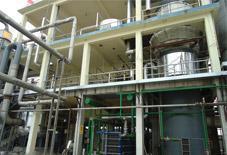As a Formaldehyde Production Plant, let me share with you.
The principle of silver-method formaldehyde reaction The silver-method
formaldehyde mainly produces main reactions and side reactions. Among them, side
reactions 3 and 4 have a certain influence on the yield of formaldehyde produced
by the main reaction. The formation of CO2 mainly occurs in the catalyst layer,
which is the product of parallel reactions; while CO and formic acid are mainly
generated after leaving the catalyst layer, which is a series of reaction
products of deep oxidation of formaldehyde. There is no effective method to
prevent CO2; however, a series of side reactions of deep oxidation after leaving
the catalyst layer can be controlled by rapidly cooling the reactants. For the
reaction of methanol oxidation to formaldehyde, if molybdenum oxide alone is
used as a catalyst, the reaction selectivity is good, but the conversion rate is
too low. Only a catalyst made of Fe-Mo oxide in an appropriate ratio can achieve
satisfactory results.

Formaldehyde Production Silver Process
The main technical reaction temperature of silver-method formaldehyde The
iron-molybdenum catalyst has poor thermal conductivity and is not resistant to
high temperatures. The reaction temperature must be strictly controlled. The
process requires the operating temperature to be 20-40°C lower than the maximum
allowable use temperature of the catalyst (ie the calcination temperature during
preparation), that is, to operate below 380°C. When the temperature exceeds
480°C, the catalyst activity is destroyed. The methanol feed concentration is
very sensitive to the effect of oxidation temperature. The absolute value of
methanol concentration increases by 0.1%, and the reaction hot spot temperature
increases by about 5°C. Therefore, the methanol concentration in the feed gas
must be kept constant. When the temperature is lower, the conversion rate of
methanol is lower, and the yield of formaldehyde is not high. As the temperature
increases, both increase. Between 300°C and 360°C, the single-pass yield of
formaldehyde can reach about 90%, but if the temperature is too high, the CO
yield will increase, while the single-pass yield of formaldehyde will decrease.
Therefore, the reaction temperature is chosen to be around 350°C.
The silver method formaldehyde raw material ratio technology is within a
certain concentration range (3%-8%). The ratio of methanol in the air mixture
has no significant effect on the yield of formaldehyde and CO. However, the
operating concentration of methanol is too low and the production capacity is
limited. . In industry, safe production is usually adopted at the highest value
of the lower limit concentration of the methanol and air mixture explosion zone,
that is, the operating concentration of methanol in the raw materials should
generally be about 6% (volume). The oxidation reaction has the characteristics
of high space velocity and large heat release. If a fluidized bed reactor is
used, the operating concentration of methanol can be increased, and the
production capacity can be greatly increased. The contact time has a very
obvious impact on the product distribution. If the contact time is too short,
The conversion rate is too low; as the contact time increases, the methanol
conversion rate increases, and the formaldehyde yield also increases, but the
yields of by-products CO and formic acid also increase, so the contact time
cannot be too long in the operation [3]. That is, methanol is oxidized with
excess air on the iron-molybdenum catalyst, which is suitable for high space
velocity conditions.
Our company also has Formaldehyde Production Silver Process on sale, welcome
to contact us.














